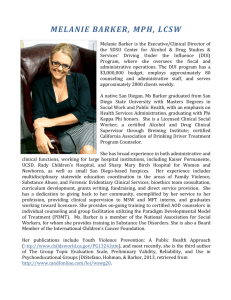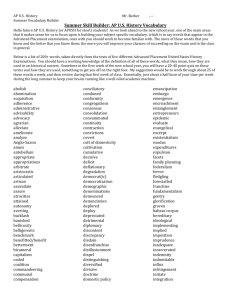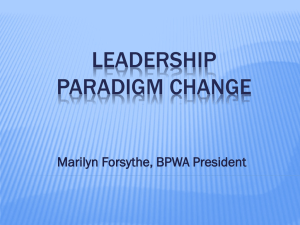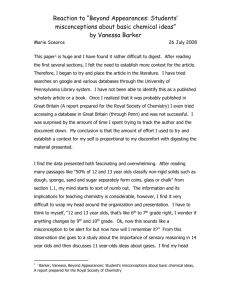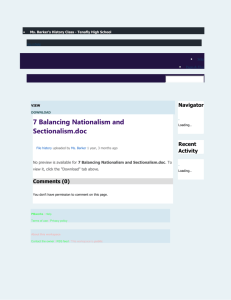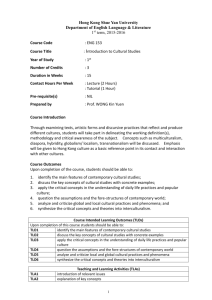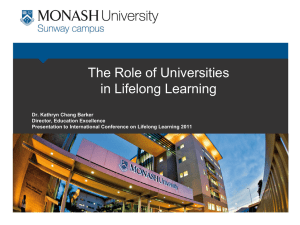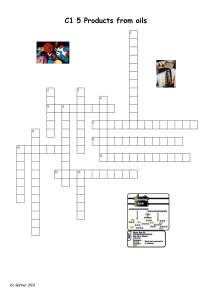Floating asset in profile
advertisement
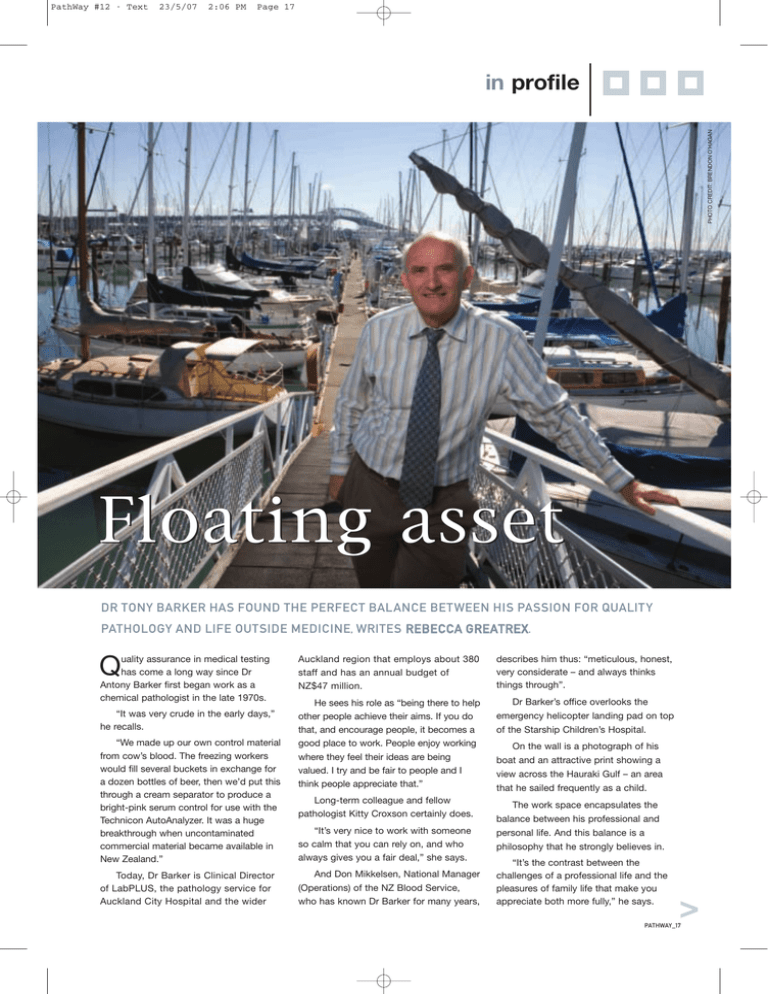
PathWay #12 - Text 23/5/07 2:06 PM Page 17 PHOTO CREDIT: BRENDON O’HAGAN in profile Floating asset DR TONY BARKER HAS FOUND THE PERFECT BALANCE BETWEEN HIS PASSION FOR QUALITY PATHOLOGY AND LIFE OUTSIDE MEDICINE, WRITES REBECCA GREATREX . uality assurance in medical testing has come a long way since Dr Antony Barker first began work as a chemical pathologist in the late 1970s. Q “It was very crude in the early days,” he recalls. “We made up our own control material from cow’s blood. The freezing workers would fill several buckets in exchange for a dozen bottles of beer, then we’d put this through a cream separator to produce a bright-pink serum control for use with the Technicon AutoAnalyzer. It was a huge breakthrough when uncontaminated commercial material became available in New Zealand.” Today, Dr Barker is Clinical Director of LabPLUS, the pathology service for Auckland City Hospital and the wider Auckland region that employs about 380 staff and has an annual budget of NZ$47 million. He sees his role as “being there to help other people achieve their aims. If you do that, and encourage people, it becomes a good place to work. People enjoy working where they feel their ideas are being valued. I try and be fair to people and I think people appreciate that.” Long-term colleague and fellow pathologist Kitty Croxson certainly does. “It’s very nice to work with someone so calm that you can rely on, and who always gives you a fair deal,” she says. And Don Mikkelsen, National Manager (Operations) of the NZ Blood Service, who has known Dr Barker for many years, describes him thus: “meticulous, honest, very considerate – and always thinks things through”. Dr Barker’s office overlooks the emergency helicopter landing pad on top of the Starship Children’s Hospital. On the wall is a photograph of his boat and an attractive print showing a view across the Hauraki Gulf – an area that he sailed frequently as a child. The work space encapsulates the balance between his professional and personal life. And this balance is a philosophy that he strongly believes in. “It’s the contrast between the challenges of a professional life and the pleasures of family life that make you appreciate both more fully,” he says. > PATHWAY_17 PathWay #12 - Text 23/5/07 2:06 PM Page 18 “I do think there’s a balance between work and the things you do outside of work that adds to both and makes them both more enjoyable.” Spirit of adventure Born in England in 1944, Dr Barker emigrated to New Zealand at the age of six. His architect father was an attractive proposition to the New Zealand government back then: it paid for the family’s passage on the Ruahine to alleviate the country’s architect shortage. The boat trip demonstrated that the young Tony’s sense of adventure was already well developed, though it included a heart-stopping incident for his parents. “There was a fancy-dress ball one night for all the children – and then I went missing. “They searched the ship for me, but there was no point in turning the ship round in the middle of the night. I was discovered the next day asleep in one of the life boats – so all was well.” The Barker family encountered another stroke of luck on that trip. They met a New Zealand judge by the name of Stanton who owned a house at Torbay. He invited his new acquaintances to live in the house, and they readily agreed. “You can imagine the contrast of going from the industrial north of England to staying in a beach house right on the sand, surrounded by paddocks,” Dr Barker says. The two families became firm friends and one of Judge Stanton’s daughters, Aileen O’Dell, had a major influence on Dr Barker’s life. Not only did he meet his future wife, Chree, during a sailing trip on Aileen’s boat during one university vacation, but Aileen was also his chemistry teacher at Takapuna Grammar School. “I was one of the lab boys, setting up the experiments for the next class, so we used to get into all sorts of mischief, as you can imagine, with a storeroom of chemicals to experiment with. We learnt a lot of chemistry, most of it outside the normal curriculum,” he laughs. CV in brief DR ANTONY (TONY) BARKER 1966 BSc 1974 MSc (Pathology) 1970 1977 1982– MB ChB MAACB, FRCPA Medical Testing Professional Advisory Committee, International Accreditation New Zealand 1983–89 Board of Education, Royal College of Pathologists of Australasia Education Committee member, Australasian Association of Clinical Biochemists 1990–96 NZ Councillor, Royal College of Pathologists of Australasia Member, Council of Medical Colleges in New Zealand 1989–96 Director of Laboratory Services, Auckland Hospital 2002– 2005– 18_PATHWAY Clinical Director, LabPLUS, Auckland District Health Board Council Member, International Accreditation New Zealand It was that interest in chemistry, though, that led him to consider a career on plant disease research, until he was advised that medical research had better funding. He studied organic chemistry and biochemistry at the University of Otago – despite being told by one of his teachers that he was “not suitable material” for university. He attributes this unlikely comment to the fact that so much of his time was devoted to sailing and athletics throughout his school years. Although the athletics has now morphed into strolls around the islands of the Hauraki Gulf, he and his wife still enjoy sailing and try to spend every other weekend on their (third) boat. “I’ve always been interested in boating,” he says, estimating that the family sails over 1000 miles each year. “It bought us close together, especially when conditions were bad.” After graduation, a short interval in the (then) very small medical laboratory at Auckland Hospital convinced him that he needed a medical degree to get an appointment as a medical researcher with a secure salary. So back he went to Otago. “As I went through medical school, I had chemical pathology in mind as my main interest. A lot of my fellow students used to tease me and say I was only choosing pathology so that I could have the weekends off to go sailing, and of course I would irritate them by agreeing with them because there was some truth in that! “I do think there’s a balance between work and the things you do outside of work that adds to both and makes them both more enjoyable.” He worked as a house surgeon in Auckland before starting an MSc in pathology in parallel with his pathology registrar training, but his thesis work convinced him that pure medical research was not for him. “I like a problem that can be solved practically within a fairly short period of time. I had to recognise that that was my personality and there was no point in pretending otherwise. My present job involves a lot of troubleshooting and sorting out issues on a day-to-day basis – I really enjoy that.” PathWay #12 - Text 23/5/07 2:06 PM Page 19 “I like a problem that can be solved practically within a fairly short period of time. I had to recognise that that was my personality and there was no point in pretending otherwise.” Enjoying family life; Right: Dr Barker and wife Chree on their first date; Opposite page: Boating trip 1984 Dr Barker is often invited to speak publicly and toured Australia last year as one of the Australasian Association of Clinical Biochemists (AACB) Current Concept Lecturers, promoting the need for reference interval standardisation, which enables laboratory results to be accurately compared. Dr Barker joined the Medical Testing Professional Advisory Committee of International Accreditation New Zealand (IANZ) soon after it was established, helping to write the laboratory accreditation-specific criteria. It was a subject that he had first presented at the AACB Conference in 1978, but back then his lecture had no impact whatsoever. Program Manager of Medical Testing at IANZ Graham Walker describes him as “highly skilled and highly capable”, and pays tribute to him as “one of the few pathologists that has dedicated his career to the less lucrative public health sector”. “People couldn’t understand how a group of competing laboratories could cooperate so closely, sharing problems and helping each other out,” he explains. But since then there has been a complete change of attitude in the profession, so it was “a pleasurable experience” to receive a very different, enthusiastic response from the audience last year. Another marked change that has occurred since the 1970s is the development of the RCPA/AACB Quality Assurance program, which Dr Barker describes as “amongst the best in the world today”. The Auckland Regional Quality Assurance Group that Dr Barker and like-minded colleagues were instrumental in setting up in 1977 to standardise reference intervals is still going strong. It now includes most laboratories in the upper North Island. “We’ve been meeting once a month for over 30 years. There has to be something of value for everybody there to keep it going, especially when people travel from as far away as New Plymouth, Whangarei and Tauranga.” Major contribution Dr Barker’s involvement with the RCPA began around the same time, when he became the chemical pathology representative on the college’s Board of Education And as if this wasn’t enough work, he was also appointed to the AACB Education Committee and helped organise and contributed to the annual RCPA/AACB chemical pathology course for six years. (His contribution to the college also includes a six-year stint as New Zealand councillor – from 1990 to 1996). By the early eighties, he and his wife had three young children, and he describes a “slightly mad” idea that saw them purchase 40 acres of land to develop into a forestry plantation. It was covered by gorse, however, and Dr Barker admits that “the family spent more time clearing this gorse – by hand – over the next 10 years than anything else put together”. It doesn’t sound relaxing, but he explains the attraction. “When you’re working in the health system there are lots of things that you cannot change so it can be very frustrating. “Some years, you feel you haven’t made a lot of advances, but the forestry block is something where you can literally see the difference that you’re creating. In retrospect though, it was a mind-boggling undertaking.” Today, the 18,000 trees that the family painstakingly planted are maturing and it’s “a lovely spot to be in”. There is still a way to go with quality assurance, though, so it’s fortunate he is not thinking of retirement just yet. One future goal is to “work with my colleagues to standardise the reference intervals used by laboratories across the whole of Australasia”, he says. “A network of regional qualityassurance groups needs to be developed to work together and share ideas and proposals for standardisation.” Given the huge amount Dr Barker has managed to achieve so far, it seems likely this is another of his goals that will become reality. PATHWAY_19
